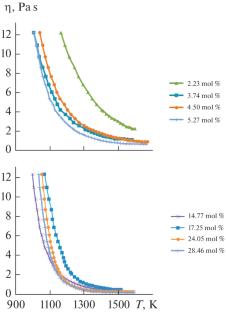硼钾k20 - b2o3熔体粘度、自由活化能和玻璃化转变温度
IF 0.6
4区 材料科学
Q4 MATERIALS SCIENCE, CERAMICS
引用次数: 0
摘要
用振动粘度计在918-1699 K的温度范围内测量了钾硼熔体的粘度。氧化钾的含量在0.74 ~ 28.46 mol %之间变化。在918 ~ 1400 K和1400 ~ 1699 K两个温度区间内,利用构型激活模型计算了熔体黏性流动参数(构型活化能εh和架桥氧原子键的移位能U∞)。用差示扫描量热法(DSC)测定了玻璃化转变温度(Tg),并给出了玻璃化转变温度与熔体中氧化钾含量的浓度关系。本文章由计算机程序翻译,如有差异,请以英文原文为准。

Viscosity, Free Activation Energy, and Glass Transition Temperature of Potassium Boron K2O–B2O3 Melts
The viscosity of potassium–boron melts is measured in the temperature range 918–1699 K using a vibrational viscosimeter. The content of potassium oxide is varied from 0.74 to 28.46 mol %. The parameters of the viscous flow in melts (the configuration–activation energy(εh) and the shifting energy of the bridging oxygen atoms’ bonds (U∞)) using the configuration–activation model are calculated for two temperature intervals 918–1400 K and 1400–1699 K. The glass transition temperature (Tg) is measured by differential scanning calorimetry (DSC) and the concentration dependence of the glass transition temperature on the content of potassium oxide in the melt is shown.
求助全文
通过发布文献求助,成功后即可免费获取论文全文。
去求助
来源期刊

Glass Physics and Chemistry
工程技术-材料科学:硅酸盐
CiteScore
1.20
自引率
14.30%
发文量
46
审稿时长
6-12 weeks
期刊介绍:
Glass Physics and Chemistry presents results of research on the inorganic and physical chemistry of glass, ceramics, nanoparticles, nanocomposites, and high-temperature oxides and coatings. The journal welcomes manuscripts from all countries in the English or Russian language.
 求助内容:
求助内容: 应助结果提醒方式:
应助结果提醒方式:


